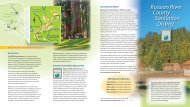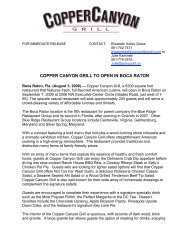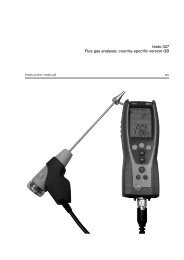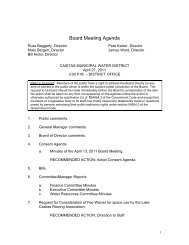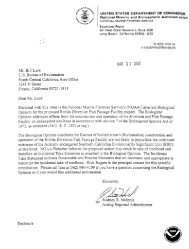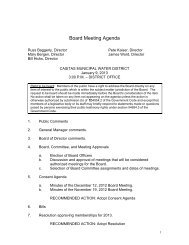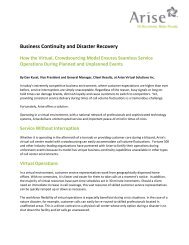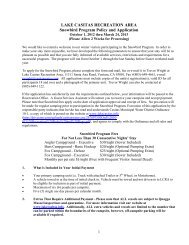The Essentials for Everglades and Estuary Restoration - DriveCMS
The Essentials for Everglades and Estuary Restoration - DriveCMS
The Essentials for Everglades and Estuary Restoration - DriveCMS
Create successful ePaper yourself
Turn your PDF publications into a flip-book with our unique Google optimized e-Paper software.
<strong>The</strong> <strong>Essentials</strong> <strong>for</strong><br />
<strong>Everglades</strong> <strong>and</strong> <strong>Estuary</strong><br />
<strong>Restoration</strong><br />
Seven years after the passage of the Water Resources Development Act of 2000<br />
(WRDA 2000) approving the Comprehensive <strong>Everglades</strong> <strong>Restoration</strong> Plan<br />
(CERP), the <strong>Everglades</strong> ecosystem remains in deep trouble. <strong>The</strong> wetl<strong>and</strong>s that<br />
define the fragile <strong>Everglades</strong> ecosystem have been joined in their distress by the<br />
estuaries on both coasts--badly damaged by the flood <strong>and</strong> drought cycle that<br />
overwhelms them with fresh water <strong>and</strong> later denies them of fresh water. Without<br />
the historic <strong>Everglades</strong>, there is no place to store the water that falls in high<br />
rainfall years. Because of this inadequacy, the modern flood control system of<br />
drainage canals discharge billions of gallons of precious fresh water into the<br />
Atlantic <strong>and</strong> Gulf.<br />
<strong>The</strong> coastal estuaries, like the <strong>Everglades</strong>, are further damaged by our failure to<br />
address water quality issues--particularly north of Lake Okeechobee, <strong>and</strong> in the<br />
Lake itself. This failure has meant that water that can be stored by the existing<br />
system <strong>for</strong> distribution is loaded with nutrients--pollutants that neither the internal<br />
wetl<strong>and</strong>s nor the estuaries can absorb without drastic changes to the health of<br />
native plants <strong>and</strong> animals.<br />
In short, despite passage of WRDA 2000, <strong>and</strong> hundreds of millions spent thus<br />
far to implement the <strong>Everglades</strong> portion of it, little progress has been made on<br />
the ground in dealing with the problems of unacceptable water quality, blocked<br />
sheetflow, <strong>and</strong> inadequate storage.<br />
Scientists in government <strong>and</strong> in the environmental community have been engaged<br />
<strong>for</strong> years in diagnosing these problems <strong>and</strong> determining science-based answers.<br />
For the past year the <strong>Everglades</strong> Foundation has been joined by a wide spectrum<br />
of national, state, <strong>and</strong> local environmental groups who have been testing <strong>and</strong><br />
refining proposed solutions. <strong>The</strong>se groups include:<br />
Audubon<br />
Audubon of Florida<br />
Clean Water Action<br />
Collier County Audubon<br />
Conservancy of Southwest Florida<br />
Defenders of Wildlife<br />
<strong>Everglades</strong> Coalition<br />
<strong>Everglades</strong> Foundation<br />
<strong>Everglades</strong> Law Center<br />
<strong>Everglades</strong> Trust<br />
FL Oceanographic Society<br />
Florida Wildlife Federation<br />
National Parks Conservation Association<br />
National Wildlife Federation<br />
Natural Resources Defense Council<br />
Rivers Coalition<br />
Sanibel-Captiva Conservation Foundation<br />
Sierra Club Foundation<br />
Tropical Audubon Society<br />
World Wildlife Fund<br />
<strong>The</strong>se partner organizations have met individually <strong>and</strong> together in<br />
plenary sessions throughout 2007 to complete <strong>The</strong> <strong>Essentials</strong> of<br />
<strong>Everglades</strong> <strong>Restoration</strong>--the steps that MUST be taken if the<br />
<strong>Everglades</strong> <strong>and</strong> estuaries are to be restored <strong>and</strong> conserved…
Essential #1<br />
Improve <strong>and</strong> protect water quality<br />
<strong>The</strong> Problem<br />
Polluted agricultural runoff <strong>and</strong> stormwater from exp<strong>and</strong>ing urban areas is unraveling the fabric of the<br />
Greater <strong>Everglades</strong> ecosystem. <strong>The</strong> natural functions of the <strong>Everglades</strong> that make it the most biologically<br />
diverse ecosystem in North America involve large amounts of water that is naturally low in nutrients <strong>and</strong><br />
driven by abundant sunshine <strong>and</strong> rainfall. Nutrient-laden runoff disrupts nutrient cycles <strong>and</strong> causes<br />
dramatic imbalances in <strong>Everglades</strong> native flora <strong>and</strong> fauna.<br />
<strong>The</strong> most serious water quality problem<br />
facing the greater <strong>Everglades</strong> <strong>and</strong> the<br />
coastal estuaries is the pollution of Lake<br />
Okeechobee. Nutrient loads far exceed<br />
state-m<strong>and</strong>ated levels <strong>and</strong> “choke” the Lake<br />
with nutrients. <strong>The</strong>se nutrients remain in the<br />
Lake <strong>for</strong> decades, causing algae blooms <strong>and</strong><br />
other indicators of profound imbalances.<br />
Phosphorus levels in Lake water now exceed<br />
150 parts per billion, about 3.5 times<br />
recommended levels.<br />
<strong>The</strong>se kinds of pollution levels are not only<br />
deadly to the Lake, the Lake’s polluted water<br />
is also discharged south into the southern<br />
<strong>Everglades</strong>—as well as to the Atlantic estuaries by way of the St. Lucie River, <strong>and</strong> to the Gulf of Mexico<br />
estuaries by way of the Caloosahatchee. At all three discharge points, the Lake’s polluted water is linked<br />
to serious degradation of these ecologically productive <strong>and</strong> economically valuable systems.<br />
<strong>The</strong> pollution in the Lake has been an issue<br />
since the late 1970s. <strong>The</strong> 1973 state legislature<br />
authorized the Special Project to Prevent the<br />
Eutrophication of Lake Okeechobee. <strong>The</strong><br />
project’s 1976 Final Report made extensive<br />
recommendations to limit nutrient pollution<br />
into the Lake. Other than the Kissimmee River<br />
Project, most of the Final Report’s<br />
recommendations were never implemented.<br />
In 1983, the South Florida Management<br />
District attempted to deal with pollution levels<br />
in the Lake by sending much of the polluted<br />
water to the <strong>Everglades</strong>--triggering almost two<br />
decades of litigation. More than $1.8 billion<br />
has been invested in clean-up, but the toll on<br />
the <strong>Everglades</strong> has been incalculable.<br />
Recent scientific data indicates the damaged areas of the <strong>Everglades</strong> continue to exp<strong>and</strong>. More than<br />
25 percent of the remaining <strong>Everglades</strong> has been damaged by excessive nutrient pollution—<br />
a 40 percent increase in just 10 years. Clearly, improvements are needed in the treatment of this<br />
nutrient-laden runoff prior to introducing it into the <strong>Everglades</strong>.<br />
<strong>The</strong> <strong>Essentials</strong> <strong>for</strong> <strong>Everglades</strong> <strong>and</strong> <strong>Estuary</strong> <strong>Restoration</strong> 2
Essential #1<br />
Improve <strong>and</strong> protect water quality<br />
<strong>The</strong> Solution<br />
<strong>The</strong> water quality problems facing Lake Okeechobee are daunting. <strong>The</strong> aggressive strategy to<br />
address this long-neglected problem involves the following actions:<br />
• Implement the proposed Best Management Practices (BMPs) in the Lake Okeechobee<br />
watershed, including the upper Kissimmee Chain of Lakes. BMPs are types of structures <strong>and</strong><br />
techniques that farmers or developers use to reduce on-site pollution. <strong>The</strong> Lake Okeechobee <strong>and</strong><br />
<strong>Estuary</strong> Recovery Plan suggests some excellent BMPs that should be realistically implemented.<br />
This BMP program also needs to be exp<strong>and</strong>ed to include innovative ways to decrease phosphorus<br />
use, decrease its mobility, <strong>and</strong> improve recovery of already-applied fertilizer.<br />
• Purchase l<strong>and</strong> <strong>and</strong> construct additional Stormwater Treatment Areas (STAs) in the<br />
<strong>Everglades</strong> Agricultural Area (EAA); <strong>and</strong> strengthen special Best Management Practices<br />
(BMPs) in the EAA. <strong>The</strong> evidence is abundantly clear that additional water treatment areas are<br />
necessary to remove the pollution from<br />
runoff water leaving the <strong>Everglades</strong><br />
Agricultural Area. An additional 45,000<br />
acres of STAs will be needed to treat the<br />
expected flows from the Lake to the<br />
<strong>Everglades</strong> (Essential #4) <strong>The</strong> BMP<br />
Program in the EAA is 15 years old <strong>and</strong> is<br />
in urgent need of refinement <strong>and</strong><br />
strengthening. Monitoring the BMP<br />
per<strong>for</strong>mance suggests several of the most<br />
successful BMPs, now voluntary, should be<br />
m<strong>and</strong>atory.<br />
• Begin the construction of STAs in<br />
the Lake Okeechobee Basin.<br />
Constructing water treatment areas<br />
north of the Lake is more complex<br />
Stormwater Treatment Areas (STA) are manmade marshes<br />
designed to remove phosphorus <strong>and</strong> other pollutants from<br />
the water column. <strong>The</strong> <strong>Essentials</strong> document that almost<br />
double the acreage proposed in CERP will be needed <strong>for</strong><br />
STAs in order to treat all of the water.<br />
than in the EAA. Still, if we infer from the experience of the existing treatment areas in the EAA, it<br />
is reasonable to predict more than 100,000 acres of STAs could be needed. <strong>The</strong> South Florida<br />
Water Management District should begin addressing this reality by identifying locations, purchasing<br />
l<strong>and</strong>s, <strong>and</strong> constructing feasible STAs--beginning with the STA features identified in the Lake<br />
Okeechobee Watershed Project.<br />
• Develop a long-range plan that will achieve the targets required in the Lake Okeechobee<br />
Recovery Act of 2000. <strong>The</strong> Northern <strong>Everglades</strong> Act of 2007 once again calls <strong>for</strong> the South Florida<br />
Water Management District to spell out the action steps the State will be taking to meet specific<br />
target goals to reduce water pollution. <strong>The</strong> State is developing a plan, but a clear roadmap <strong>for</strong><br />
getting to the pollution goals will be necessary if pollution goals will actually be met.<br />
<strong>The</strong> <strong>Essentials</strong> <strong>for</strong> <strong>Everglades</strong> <strong>and</strong> <strong>Estuary</strong> <strong>Restoration</strong> 3
Essential #1<br />
Improve <strong>and</strong> protect water quality<br />
<strong>The</strong> Solution continued…<br />
• Invest in new technologies <strong>and</strong> studies to address<br />
other types of water pollution beyond<br />
phosphorus. While phosphorus levels in<br />
<strong>Everglades</strong> water is of primary concern, other types<br />
of pollution also threaten the <strong>Everglades</strong> <strong>and</strong><br />
estuaries. New research on reducing mercury,<br />
nitrates, <strong>and</strong> other substances like herbicides <strong>and</strong><br />
pesticides must be implemented.<br />
• Limit water quality degradation associated with<br />
new developments in the <strong>Everglades</strong> watershed.<br />
New development must be designed with<br />
assurances that their stormwater is managed <strong>and</strong><br />
retained on-site whenever possible, <strong>and</strong> that<br />
appropriate treatment will prevent any further<br />
degradation to water quality. This will require<br />
significant additional water storage in each new<br />
development project.<br />
• <strong>The</strong> South Florida Water Management District<br />
should inventory <strong>and</strong> model the entire range of<br />
public <strong>and</strong> private canals <strong>and</strong> water control<br />
structures in the Lake Okeechobee Basin.<br />
<strong>The</strong> District should then institute a project to<br />
place control structures in uncontrolled canals <strong>and</strong><br />
ditches to restore more natural groundwater levels,<br />
<strong>and</strong> when possible, recreate shallow marsh<br />
wetl<strong>and</strong>s in cooperation with l<strong>and</strong>owners.<br />
Specifically, surface water quality control ef<strong>for</strong>ts<br />
should be incorporated into restoration ef<strong>for</strong>ts<br />
related to water storage features within the<br />
Upper Chain of Lakes Headwaters Revitalization<br />
Project, Lake Istokpoga’s watershed, <strong>and</strong> the<br />
more recent Northern <strong>Everglades</strong> initiative.<br />
Above: Under phosphorus enrichment cattails outcompete <strong>and</strong> replace<br />
sawgrass, <strong>for</strong>ming dense st<strong>and</strong>s of vegetation that impede water flow<br />
<strong>and</strong> reduce habitat quality.<br />
Right: Recreating a more natural timing <strong>and</strong> distribution of water<br />
will allow <strong>for</strong> a more natural annual wetting <strong>and</strong> drying cycle in the<br />
<strong>Everglades</strong> marshes, which will in turn provide improved habitat.<br />
<strong>The</strong> <strong>Essentials</strong> <strong>for</strong> <strong>Everglades</strong> <strong>and</strong> <strong>Estuary</strong> <strong>Restoration</strong> 4
Essential #2<br />
Restore the Kissimmee River Watershed<br />
<strong>Restoration</strong> ef<strong>for</strong>ts on the Kissimmee River Floodplain<br />
have demonstrated that <strong>Everglades</strong> restoration is<br />
feasible <strong>and</strong> can be successful.<br />
<strong>The</strong> Problem<br />
Historically, the Kissimmee River flowed south from<br />
Lake Kissimmee to Lake Okeechobee over a 103-mile<br />
long shallow path. <strong>The</strong> me<strong>and</strong>ering river was very<br />
shallow <strong>and</strong> created a vast floodplain up to two miles<br />
wide. Covering approximately 50,000 acres, this<br />
floodplain contained a diverse mosaic of wetl<strong>and</strong><br />
communities that supported birds, fish, <strong>and</strong> other<br />
wildlife. <strong>The</strong> Kissimmee River’s me<strong>and</strong>ering flow<br />
moderated high water <strong>and</strong> wet season flows,<br />
sequestering nutrients <strong>and</strong> sediments be<strong>for</strong>e releasing<br />
water into Lake Okeechobee.<br />
But in the late 1960’s, the Kissimmee was trans<strong>for</strong>med into<br />
a 56-mile long ditch, eliminating two-thirds of the<br />
historical wetl<strong>and</strong>s, <strong>and</strong> destroying valuable wintering<br />
waterfowl <strong>and</strong> fish habitats. <strong>The</strong> river’s trans<strong>for</strong>mation<br />
also impacted the Upper Chain of Lakes—reducing their<br />
depth <strong>and</strong> <strong>for</strong>cing their flows into strictly regulated<br />
discharges sent rapidly into Lake Okeechobee. <strong>The</strong> folly<br />
of ditching the Kissimmee River was recognized almost the<br />
day it was completed, <strong>and</strong> the magnitude of the ecological<br />
catastrophe led to public outcry.<br />
Three decades after the initial hearings <strong>and</strong> investigations<br />
by the Corps of Engineers, there has been real progress in<br />
reversing this disaster. Almost 22 miles of the middle<br />
section of the canal will be filled in, <strong>and</strong> about half of the<br />
floodplain will be restored. <strong>The</strong> recovery of wetl<strong>and</strong><br />
function has been much faster than expected, with rapid recolonization<br />
by native plants <strong>and</strong> animals.<br />
<strong>The</strong> Kissimmee River <strong>Restoration</strong> is a true Florida<br />
environmental success story three decades in the making.<br />
But much more can be done. <strong>The</strong> Kissimmee Valley<br />
remains one of the most pristine <strong>and</strong> beautiful natural<br />
areas in Florida. We need to act now to continue the<br />
restoration ef<strong>for</strong>ts, <strong>and</strong> make the Kissimmee Valley a<br />
lasting legacy.<br />
<strong>The</strong> <strong>Essentials</strong> <strong>for</strong> <strong>Everglades</strong> <strong>and</strong> <strong>Estuary</strong> <strong>Restoration</strong> 5
Essential #2<br />
Restore the Kissimmee River Watershed<br />
<strong>The</strong> Solution<br />
<strong>The</strong> question is now “Where should the restoration of the Kissimmee River basin proceed<br />
next?” Watershed restoration in the lower basin, floodplain restoration in the lower<br />
Kissimmee River, <strong>and</strong> headwaters enhancements in the upper basin are key to the<br />
restoration of the Kissimmee River Watershed. <strong>The</strong>se ef<strong>for</strong>ts include projects in four subbasins--the<br />
Indian Prairie sub-basin, the S-65D basin, the Paradise Run reach of the lower<br />
Kissimmee River, <strong>and</strong> the Upper Chain of Lakes.<br />
• Improve wetl<strong>and</strong>s in the Indian Prairie Marsh. <strong>The</strong> area between Lake Istokpoga <strong>and</strong><br />
Lake Okeechobee known as the Indian Prairie Marsh once functioned as a “mini-<br />
<strong>Everglades</strong>.” 115,500 acres of <strong>for</strong>mer wetl<strong>and</strong>s in this area have been identified that could<br />
provide functional water retention, <strong>and</strong> could become restored marshes. Degrading the<br />
northwestern section of the Herbert Hoover Dike would reconnect these wetl<strong>and</strong>s with Lake<br />
Okeechobee, providing enormous habitat benefits.<br />
<strong>The</strong> <strong>Essentials</strong> <strong>for</strong> <strong>Everglades</strong> <strong>and</strong> <strong>Estuary</strong> <strong>Restoration</strong> 6
Essential #2<br />
Restore the Kissimmee River Watershed<br />
<strong>The</strong> Solution continued…<br />
• Work with ranchers in the S-65D basin to protect wetl<strong>and</strong>s in the watershed.<br />
Approximately 24,000 acres in the S-65D sub-basin represent pastures that have soils <strong>and</strong><br />
elevations that would sustain wetl<strong>and</strong>s. <strong>The</strong>se l<strong>and</strong>s (shown in orange below), are excellent<br />
c<strong>and</strong>idates <strong>for</strong> conservation programs such as the Wetl<strong>and</strong> Reserve Program, or other<br />
programs that offer incentives to rural l<strong>and</strong>owners <strong>for</strong> providing water recharge <strong>and</strong> storage<br />
benefits on their property.<br />
• Restore the Paradise Run<br />
section of the Kissimmee River.<br />
This is the last reach of the<br />
Kissimmee River be<strong>for</strong>e it<br />
empties into Lake Okeechobee.<br />
This section of historic floodplain<br />
could be restored much like the<br />
section further north, recovering<br />
an additional 10 miles of river<br />
<strong>and</strong> 3,950 acres of high quality<br />
habitat without requiring the<br />
expensive task of filling the<br />
C-38.<br />
• Improve hydrologic conditions<br />
in the Upper Chain of Lakes,<br />
including Lake Kissimmee,<br />
Lake Hatchineha <strong>and</strong> Cypress<br />
Lake. <strong>The</strong>se lakes are highly<br />
managed, <strong>and</strong> while there will be<br />
some improvements from the<br />
Headwaters Revitalization<br />
Project, additional changes are<br />
needed. <strong>The</strong> regulation schedules<br />
<strong>for</strong> the lakes <strong>and</strong> canals need to<br />
simulate the natural patterns of<br />
wetting <strong>and</strong> drying, <strong>and</strong> vary with<br />
the amount of rainfall. This ef<strong>for</strong>t<br />
will require the South Florida<br />
Water Management District to<br />
acquire more l<strong>and</strong> <strong>and</strong> replace<br />
water control structures with<br />
more sophisticated equipment to<br />
hold additional water.<br />
<strong>The</strong> <strong>Essentials</strong> <strong>for</strong> <strong>Everglades</strong> <strong>and</strong> <strong>Estuary</strong> <strong>Restoration</strong> 7
<strong>Essentials</strong> #3, #4, #5<br />
Construct the requisite storage <strong>and</strong> flow<br />
to restore the <strong>Everglades</strong>, the estuaries, <strong>and</strong> Lake Okeechobee<br />
<strong>The</strong> Background<br />
When the southern reaches of the Hoover Dike were completed around Lake Okeechobee in 1933, the<br />
<strong>Everglades</strong> lost most of its water supply. Without water from Lake Okeechobee's watershed, the<br />
<strong>Everglades</strong> became much drier, causing reduced productivity in Florida Bay as well as in the Gulf Coast<br />
estuaries.<br />
Water that historically flowed south was directed to the east coast by the St. Lucie River <strong>and</strong> the west<br />
coast by the Caloosahatchee River. This caused the coastal estuaries to bear the brunt of huge amounts of<br />
damaging fresh water releases from Lake Okeechobee.<br />
Decades of relentless drainage of the <strong>Everglades</strong> marshes coupled with lowered Lake Okeechobee water<br />
levels has decreased the amount of space available to store water--the amount of water the natural systems<br />
need to get them through the dry season, <strong>and</strong> through times when rainy season does not bring its usual<br />
bounty. As a consequence of not being able to save water, the remnant <strong>Everglades</strong> ecosystem is very<br />
susceptible to floods <strong>and</strong> droughts.<br />
If the <strong>Everglades</strong> is to survive, the storage that was inherent in the vast spatial extent of its natural<br />
wetl<strong>and</strong>s must be recovered. This need to store additional water is of paramount importance to the<br />
Comprehensive <strong>Everglades</strong><br />
<strong>Restoration</strong> Plan (CERP).<br />
CERP calls <strong>for</strong> huge increases in<br />
storage--some 10.6 million acrefeet<br />
in new storage which is<br />
roughly equivalent to the amount<br />
of water in four Lake<br />
Okeechobees.<br />
<strong>The</strong> fate of CERP relies on the plan's<br />
ability to provide this storage. Yet<br />
the 2000 plan suggested that 90<br />
percent of this new storage could be<br />
provided by Aquifer Storage <strong>and</strong><br />
Recovery (ASR) wells. Beyond the<br />
ASRs, CERP also planned to store<br />
another 3 percent of the water<br />
necessary in “reclaimed” rock mines.<br />
Today both technologies are<br />
recognized as extremely risky <strong>and</strong><br />
of highly uncertain feasibility.<br />
Long-promised ASR contingency<br />
plans have not been delivered by<br />
the State <strong>and</strong> federal partner<br />
agencies; <strong>Essentials</strong> #3, #4, <strong>and</strong> #5<br />
propose just such a contingency<br />
plan.<br />
<strong>The</strong> <strong>Essentials</strong> <strong>for</strong> <strong>Everglades</strong> <strong>and</strong> <strong>Estuary</strong> <strong>Restoration</strong> 8
<strong>Essentials</strong> #3, #4, #5<br />
Construct the requisite storage <strong>and</strong> flow<br />
to restore the <strong>Everglades</strong>, the estuaries, <strong>and</strong> Lake Okeechobee<br />
<strong>The</strong> Key Concept<br />
<strong>The</strong> concepts of<br />
storage <strong>and</strong> flow are<br />
linked.<br />
During wet years,<br />
three actions must<br />
occur:<br />
First, store sufficient<br />
water in a surface<br />
reservoir to supply the<br />
<strong>Everglades</strong> with enough<br />
water during droughts.<br />
(Essential #3)<br />
Second, after treating<br />
the water to remove<br />
pollutants, send as<br />
much water from Lake<br />
Okeechobee as possible<br />
to the <strong>Everglades</strong>.<br />
(Essential #4)<br />
And finally, construct<br />
enough additional<br />
storage to prevent<br />
damaging discharges to<br />
the estuaries, <strong>and</strong> use<br />
this water <strong>for</strong> drought<br />
supplies to the Lake<br />
<strong>and</strong> <strong>for</strong> other water<br />
needs. This is the<br />
operational strategy that<br />
minimizes storage<br />
need, but restores the<br />
estuaries <strong>and</strong> the<br />
<strong>Everglades</strong>.<br />
(Essential #5)<br />
<strong>The</strong> <strong>Essentials</strong> <strong>for</strong> <strong>Everglades</strong> <strong>and</strong> <strong>Estuary</strong> <strong>Restoration</strong> 9
Essential #3<br />
Provide adequate water storage <strong>for</strong> the ecological needs<br />
of <strong>Everglades</strong> National Park <strong>and</strong> the Water Conservation Areas (WCAs)<br />
<strong>The</strong> Problem<br />
<strong>The</strong> <strong>Everglades</strong> used to flow as a broad,<br />
shallow sheet of water through a marsh<br />
roughly the size of New Jersey. This<br />
“sheetflow” was a defining characteristic of<br />
the <strong>Everglades</strong>.<br />
One of the major engineering challenges to<br />
completing the Comprehensive <strong>Everglades</strong><br />
<strong>Restoration</strong> Plan (CERP) is figuring out how to<br />
sustain the River of Grass during droughts--<br />
given that about half of the wetl<strong>and</strong>s in the<br />
<strong>Everglades</strong> are gone, <strong>and</strong> the Lake is no longer<br />
as deep as it once was.<br />
<strong>The</strong> Solution<br />
<strong>Everglades</strong> Foundation computer simulations<br />
indicate that to maintain sheetflow <strong>and</strong><br />
ecological function in the <strong>Everglades</strong> during<br />
droughts, approximately 1.5 million acre-ft of<br />
storage is needed. Moreover, a true cost<br />
accounting will show that the most reliable,<br />
<strong>The</strong> John Harshberger Map of 1913 shows that the <strong>Everglades</strong><br />
was a continuous wetl<strong>and</strong> system from just north of Orl<strong>and</strong>o to<br />
Florida Bay. Note the “mini-<strong>Everglades</strong>” north of the Lake on<br />
the western side.<br />
lowest cost storage is a surface reservoir in the<br />
<strong>Everglades</strong> Agricultural Area.<br />
This analysis indicates the need to:<br />
• Construct a 1.5 million acre-ft reservoir in the EAA fed by releases from Lake<br />
Okeechobee during wet years that will supply water to the <strong>Everglades</strong> during dry seasons<br />
<strong>and</strong> droughts.<br />
• Implement a plan <strong>for</strong> full removal of barriers to sheetflow in Water Conservation<br />
Area 3 <strong>and</strong> <strong>Everglades</strong> National Park. This would allow a natural drying pattern that<br />
would result in the greatest benefit to the <strong>Everglades</strong>.<br />
• Build seepage control features along the eastern side of the <strong>Everglades</strong> Protection<br />
Area. Controlling the loss of water from seepage during droughts will help stabilize drying<br />
patterns during droughts.<br />
<strong>The</strong> <strong>Essentials</strong> <strong>for</strong> <strong>Everglades</strong> <strong>and</strong> <strong>Estuary</strong> <strong>Restoration</strong> 10
Essential # 4<br />
Provide <strong>for</strong> large wet year flows<br />
from Lake Okeechobee to the <strong>Everglades</strong><br />
<strong>The</strong> Problem<br />
Historically, water from Lake Okeechobee spilled out into this vast wetl<strong>and</strong>, which then flowed<br />
into the areas known today as the Water Conservation Areas. <strong>The</strong> primary reason <strong>for</strong> diverting<br />
the water from Lake Okeechobee to the St. Lucie <strong>and</strong> Caloosahatchee estuaries was to create the<br />
<strong>Everglades</strong> Agricultural Area (EAA). If the connection between the Lake <strong>and</strong> the <strong>Everglades</strong> is<br />
ever to be re-established to relieve the need <strong>for</strong> discharges to the estuaries, water from Lake<br />
Okeechobee must be passed through the EAA.<br />
• How much water from Lake Okeechobee can be sent southward?<br />
• What will it take to clean up the polluted Lake water be<strong>for</strong>e it reaches the <strong>Everglades</strong>?<br />
• What is the best way to convey the water from the Lake to the <strong>Everglades</strong>?<br />
<strong>The</strong> Solution<br />
By employing the same modeling simulations that agencies<br />
use to examine those three key questions, Foundation<br />
scientists have determined that the amount of water that can<br />
be sent to the <strong>Everglades</strong> depends upon how much of the<br />
barriers to sheetflow are removed (Essential #6).<br />
CERP only plans to partially remove the barriers <strong>and</strong> will<br />
send very little water from the Lake to the <strong>Everglades</strong><br />
during wet years. CERP relies heavily on a system of<br />
Aquifer Storage <strong>and</strong> Recovery (ASR) wells to store the<br />
water underground instead of having it flow through the<br />
<strong>Everglades</strong>.<br />
However, if the recommendations in Essential #6 are<br />
implemented, an estimated 1.25 million acre-ft of water<br />
could be moved from the Lake through the <strong>Everglades</strong><br />
during wet years. This would decrease the need <strong>for</strong> ASR<br />
well <strong>and</strong> other storage by up to 40 percent.<br />
Un<strong>for</strong>tunately this water is excessively high in nutrients,<br />
with phosphorus concentrations in Lake Okeechobee that<br />
are currently more than 15 times higher than suitable <strong>for</strong><br />
the <strong>Everglades</strong>. And because Lake Okeechobee has<br />
Historically water flowed generally in a<br />
southerly direction from Lake Okeechobee to<br />
Florida Bay unimpeded by the canals <strong>and</strong><br />
dikes currently present.<br />
amassed some 200 million cubic meters of polluted mud that covers roughly half the Lake's<br />
bottom, it is predicted that pollution levels in the Lake will remain above the phosphorus goal <strong>for</strong><br />
decades after inflow water quality goals are met.<br />
<strong>The</strong> <strong>Essentials</strong> <strong>for</strong> <strong>Everglades</strong> <strong>and</strong> <strong>Estuary</strong> <strong>Restoration</strong> 11
Essential # 4<br />
Provide <strong>for</strong> large wet year flows<br />
from Lake Okeechobee to the <strong>Everglades</strong><br />
<strong>The</strong> Solution continued…<br />
Water from the Lake will need treatment to remove pollutants be<strong>for</strong>e sending to the <strong>Everglades</strong>--<br />
<strong>and</strong> treating this water to acceptable levels of nutrients will require doubling the current number<br />
of Stormwater Treatment Areas (STAs) by using an additional 45,000 acres.<br />
How best to convey the water, depends on perspective. From a strictly engineering viewpoint,<br />
“best” is a canal, which has no ecological value but is efficient at moving water. From an<br />
ecological perspective, “best” is a full recovery of the pre-drainage wetl<strong>and</strong> function, both<br />
hydrologic <strong>and</strong> ecologic. <strong>The</strong> <strong>Everglades</strong> Foundation is committed to finding a cost-effective<br />
solution, one that considers system-wide environmental benefits.<br />
Providing <strong>for</strong> large wet year flows from Lake Okeechobee to the <strong>Everglades</strong> will require:<br />
• <strong>The</strong> construction of an additional 45,000 acres of additional STAs in the EAA.<br />
• <strong>The</strong> removal of the barriers to flow<br />
including canals, levees, <strong>and</strong> other water<br />
management structures in Water<br />
Conservation Area 3A (Essential #6).<br />
This will accommodate the movement of<br />
up to 1.2 million acre-ft from Lake<br />
Okeechobee into the <strong>Everglades</strong> during<br />
wet years, <strong>and</strong> cutting the total storage<br />
need by up to 40 percent.<br />
• <strong>The</strong> construction of a cost-effective<br />
conveyance system that improves<br />
ecological function while moving large<br />
water volumes during wet years.<br />
• Developing a means to remove or treat<br />
Lake Okeechobee's mud center to<br />
accelerate water quality improvements<br />
<strong>and</strong> reduce cleansing dem<strong>and</strong>s on other<br />
water quality features.<br />
Alligator tracks w<strong>and</strong>er across the exposed mud of Lake<br />
Okeechobee during the drought of 2007<br />
<strong>The</strong> <strong>Essentials</strong> <strong>for</strong> <strong>Everglades</strong> <strong>and</strong> <strong>Estuary</strong> <strong>Restoration</strong> 12
Large volumes of polluted water are frequently released into the<br />
St. Lucie Canal from Lake Okeechobee, in some instances causing<br />
large pollution plumes in the Atlantic Ocean.<br />
Essential # 5<br />
Provide additional water storage<br />
to protect the estuaries <strong>and</strong> Lake Okeechobee<br />
<strong>The</strong> Problem<br />
<strong>The</strong> water issues surrounding Lake Okeechobee <strong>and</strong> the St. Lucie <strong>and</strong> Caloosahatchee estuaries<br />
are as complex <strong>and</strong> contentious as any in the country. When the southern reaches of the Herbert<br />
Hoover Dike was completed in 1933, outflows from the Lake to the <strong>Everglades</strong> were cut off--<br />
with all major releases sent to the St. Lucie <strong>and</strong> Caloosahatchee instead. During these<br />
destructive releases, plumes of nutrient <strong>and</strong> sediment-laden water from Lake Okeechobee are<br />
observed well into the Gulf of Mexico <strong>and</strong> the Atlantic Ocean. <strong>The</strong> pollution of Lake<br />
Okeechobee, which only gets worse with each passing year, has further aggravated the problems<br />
associated with these releases adding the threat of algae blooms, low dissolved oxygen levels,<br />
fish lesions, <strong>and</strong> a host of other maladies that damage these delicate estuarine systems <strong>and</strong><br />
threatens the <strong>Everglades</strong>.<br />
Artificial manipulation of water<br />
levels within Lake Okeechobee<br />
started in the 1880s <strong>and</strong><br />
continues today. Around 1913,<br />
water levels in the Lake<br />
dropped from around 22 feet<br />
above mean sea level to about<br />
15 feet above mean sea level,<br />
primarily to provide flood<br />
control. As a result, large<br />
releases have been sent to the<br />
estuaries during wet years ever<br />
since. By maintaining Lake<br />
Okeechobee at these lower<br />
levels, the system has also lost<br />
its single largest place to store<br />
water in the <strong>Everglades</strong>.<br />
Attempts to establish a fishery in<br />
the Lake by maintaining low levels has been hampered by the highly variable inflows. <strong>The</strong>se<br />
inflows also confound attempts to compensate <strong>for</strong> high nutrient levels in the Lake by holding the<br />
Lake at lower stages.<br />
Adding to the environmental woes of the Lake are the operational rules, which are largely<br />
determined by flood control <strong>and</strong> water supply. An aging Herbert Hoover Dike has limited<br />
options <strong>for</strong> the Lake. Fearing a levee failure, the U.S. Army Corps of Engineers has opted <strong>for</strong><br />
large <strong>and</strong> sustained releases to the estuaries.<br />
As a result of trying to manage the Lake <strong>for</strong> various interests, no one is satisfied <strong>and</strong> these<br />
policies have created the “perfect storm” <strong>for</strong> a collapse of the Lake.<br />
<strong>The</strong> <strong>Essentials</strong> <strong>for</strong> <strong>Everglades</strong> <strong>and</strong> <strong>Estuary</strong> <strong>Restoration</strong> 13
Essential # 5<br />
Provide additional water storage<br />
to protect the estuaries <strong>and</strong> Lake Okeechobee<br />
<strong>The</strong> Solution<br />
<strong>The</strong> answer to the problem of discharges to the estuaries <strong>and</strong> to the wild swings in Lake<br />
Okeechobee water levels is straight<strong>for</strong>ward: More Storage.<br />
<strong>The</strong> Comprehensive <strong>Everglades</strong> <strong>Restoration</strong> Plan (CERP) proposed solving the storage issues in<br />
the Lake with Aquifer Storage <strong>and</strong> Recovery (ASR) wells, where water is pumped underground<br />
instead of diverted to the estuaries or the <strong>Everglades</strong>, <strong>and</strong> then recovered later. Recent<br />
simulations estimate Lake Okeechobee ASR storage at 5.4 million acre-ft--roughly 4.5 times the<br />
capacity of the Lake itself. Given the inherent risks with ASR at this massive scope, practicality<br />
would suggest looking at a variety of alternative solutions. <strong>The</strong>se solutions, including deep<br />
reservoir technology, should be evaluated to assess cost, energy efficiency, <strong>and</strong> overall<br />
ecological benefits to the system.<br />
This storage requirement can be significantly reduced by a few common-sense steps. First,<br />
send as much water as possible (after treatment) through the <strong>Everglades</strong> (Essential #4).<br />
Secondly, construct about 1.5 million acre-ft of storage <strong>for</strong> water supply in the <strong>Everglades</strong><br />
Agricultural Area (Essential #3). <strong>The</strong>n, build about 2.8 million acre-ft of additional<br />
storage, near Lake Okeechobee, which will buffer lake stages (changes in water levels) <strong>and</strong><br />
eliminate damaging discharges to the estuaries.<br />
Un<strong>for</strong>tunately no single solution is likely to appear that will realize capacities of this magnitude.<br />
<strong>The</strong>re<strong>for</strong>e, several approaches are called <strong>for</strong>:<br />
• Increase natural wetl<strong>and</strong>, groundwater,<br />
<strong>and</strong> lake storage in the Lake Okeechobee<br />
watershed. Restoring wetl<strong>and</strong> function to<br />
the wetl<strong>and</strong>s in the Kissimmee River basin,<br />
the Lake Istokpoga basin, <strong>and</strong> Upper Chain<br />
of Lakes (Essential #2) will greatly ease the<br />
amount of water draining into the Lake from<br />
the north, easing the pressure on Lake levels<br />
that require estuary discharges.<br />
Hundreds of miles of private drainage<br />
ditches flow toward South Florida Water<br />
Management District canals with few<br />
modern water control structures. <strong>The</strong>se<br />
ditches over drain the l<strong>and</strong> <strong>and</strong><br />
unnecessarily lower groundwater levels-<br />
-sending the water toward Lake<br />
Okeechobee far too quickly.<br />
Inventorying, modeling, <strong>and</strong> modernizing<br />
this haphazard drainage system with<br />
Discharges of polluted water from Lake Okeechobee into the<br />
Caloosahatchee Canal cause massive blooms of algae which<br />
in turn cause fish kills due to low oxygen levels in the water<br />
column<br />
<strong>The</strong> <strong>Essentials</strong> <strong>for</strong> <strong>Everglades</strong> <strong>and</strong> <strong>Estuary</strong> <strong>Restoration</strong> 14
Essential # 5<br />
Provide additional water storage<br />
to protect the estuaries <strong>and</strong> Lake Okeechobee<br />
<strong>The</strong> Solution continued…<br />
new control structures could add millions of feet of storage. Additionally, programs to<br />
encourage <strong>and</strong> increase water storage on private l<strong>and</strong>s should be pursued <strong>and</strong> implemented.<br />
• Consider a suite of storage options, including surface storage in the Kissimmee basin<br />
<strong>and</strong> in the <strong>Everglades</strong> Agricultural Area (EAA) south of the Lake. Finding an effective<br />
<strong>and</strong> efficient storage solution will require constructing a storage feature along with an<br />
aggressive program to restore wetl<strong>and</strong>s in the Kissimmee River Watershed.<br />
• Thoroughly examine the trade-offs of raising the level of Lake Okeechobee <strong>for</strong><br />
additional storage. <strong>The</strong> National Academy of Sciences review of storage options suggests<br />
that scientists investigate <strong>and</strong> report on the options <strong>and</strong> trade-offs related to Lake levels.<br />
Only then can an in<strong>for</strong>med decision be determined.<br />
• Proceed with the repair of Herbert Hoover Dike. <strong>The</strong> U.S. Army Corps of Engineers is<br />
supported in their ef<strong>for</strong>ts to rehabilitate Herbert Hoover Dike. <strong>The</strong> Corps also needs to be<br />
vigilant in controlling activities that undermine the integrity of this structure, or preclude<br />
future retrofits--such as incompatible l<strong>and</strong> uses like rock mining <strong>and</strong> development adjacent to<br />
the levee.<br />
<strong>The</strong> <strong>Everglades</strong><br />
Agricultural Area<br />
(EAA) is over 700,000<br />
acres in size,<br />
equivalent to the size of<br />
Lake Okeechobee. Soil<br />
loss has dropped l<strong>and</strong><br />
elevations as much as 6<br />
feet in the agricultural<br />
area, making it<br />
virtually impossible to<br />
recreate a natural<br />
flowway from the lake<br />
to the southern<br />
<strong>Everglades</strong>.<br />
<strong>The</strong> <strong>Essentials</strong> <strong>for</strong> <strong>Everglades</strong> <strong>and</strong> <strong>Estuary</strong> <strong>Restoration</strong> 15
Essential #6<br />
Restore historic sheetflow within the <strong>Everglades</strong><br />
by removing artificial impediments to flow<br />
<strong>The</strong> Problem<br />
<strong>The</strong> concepts of storage <strong>and</strong> flow are linked, <strong>and</strong> during wet years three actions are needed.<br />
First, sufficient water must be stored in a surface reservoir to supply the <strong>Everglades</strong> with water<br />
during droughts (Essential #3). Next, as much water as possible needs to be treated to remove<br />
pollutants, <strong>and</strong> that water must be conveyed South to the <strong>Everglades</strong>.<br />
<strong>The</strong> historic flow of the <strong>Everglades</strong> has been truncated by a<br />
series of canals <strong>and</strong> dikes that have compartmentalized the<br />
remaining <strong>Everglades</strong>’ habitat.<br />
While attempts to modify the <strong>Everglades</strong><br />
l<strong>and</strong>scape date to the 1800s, the<br />
construction of the Central <strong>and</strong> Southern<br />
Florida Flood Control Project starting in the<br />
late 1940s was unprecedented in scale. <strong>The</strong><br />
<strong>Everglades</strong>, once a slow-moving, broad,<br />
shallow sheet of water was dammed <strong>and</strong><br />
ditched until it became a series of<br />
reservoirs--with only the <strong>Everglades</strong><br />
National Park remaining free-flowing. <strong>The</strong><br />
flow of this sheet of water (“sheetflow”) is<br />
recognized as one of the defining<br />
characteristics of the <strong>Everglades</strong>. Nearly<br />
all of the basic processes of the <strong>Everglades</strong>,<br />
such as nutrient cycling, wetting <strong>and</strong> drying<br />
patterns, fire, soil <strong>for</strong>mation, <strong>and</strong> vegetation<br />
patterns are dependent on flowing water.<br />
Not all of the remaining <strong>Everglades</strong> can be restored to a flowing sheet of water. But sheetflow<br />
can be recovered in the largest remnant tract of <strong>Everglades</strong>. By reconnecting the State-owned<br />
Water Conservation Area 3 to the federally-owned <strong>Everglades</strong> National Park, the southern-most<br />
piece of the River of Grass can be restored.<br />
This recovery of sheetflow is especially critical to the St. Lucie <strong>and</strong> Caloosahatchee<br />
estuaries. Unless the barriers to sheetflow are removed, it will not be possible to put large,<br />
wet year flows from Lake Okeechobee into the <strong>Everglades</strong>. <strong>The</strong> only alternative is releases<br />
to the estuaries. Unless these dams <strong>and</strong> diversion canals are removed, large flows will<br />
simply pile up, obliterating the <strong>Everglades</strong>. <strong>The</strong> key to improving the health of the<br />
estuaries is the removal of these barriers.<br />
<strong>The</strong> <strong>Everglades</strong> cannot be restored without restoring sheetflow. <strong>The</strong> Caloosahatchee <strong>and</strong><br />
St. Lucie estuaries cannot be protected without restoring sheetflow. Freshwater flows to<br />
Florida Bay cannot be restored without restoring sheetflow.<br />
<strong>The</strong> <strong>Essentials</strong> <strong>for</strong> <strong>Everglades</strong> <strong>and</strong> <strong>Estuary</strong> <strong>Restoration</strong> 16
Essential #6<br />
Restore historic sheetflow within the <strong>Everglades</strong><br />
by removing artificial impediments to flow<br />
<strong>The</strong> Solution<br />
1. Remove the<br />
L-67A <strong>and</strong><br />
L-67C levees<br />
<strong>and</strong> canals<br />
2. Remove the<br />
L-29 levee<br />
3. Remove the<br />
L-28 levee<br />
4. Bridge the<br />
Tamiami Trail<br />
<strong>and</strong> remove the<br />
existing Tamiami<br />
Trail (SR 41) as<br />
an impediment<br />
to sheetflow<br />
5. Implement<br />
seepage control<br />
along the east<br />
side of the<br />
<strong>Everglades</strong><br />
6. Remove the<br />
Miami Canal<br />
<strong>The</strong> goal of Decompartmentalization is to reconnect large segments of the remaining<br />
<strong>Everglades</strong>, allowing <strong>for</strong> sheetflow to once again be the predominant hydrologic<br />
feature.<br />
<strong>The</strong> <strong>Essentials</strong> <strong>for</strong> <strong>Everglades</strong> <strong>and</strong> <strong>Estuary</strong> <strong>Restoration</strong> 17
Essential #7<br />
Restore Florida Bay <strong>and</strong> improve Biscayne Bay<br />
by restoring sheetflow in the southern Glades<br />
<strong>The</strong> Problem<br />
Florida Bay <strong>and</strong> Biscayne Bay are among the most spectacular natural treasures anywhere on<br />
Earth. With almost all of Florida Bay within <strong>Everglades</strong> National Park <strong>and</strong> about half of<br />
Biscayne Bay within Biscayne National Park, they enjoy the highest level of national <strong>and</strong><br />
international protection. Moreover, these bays contribute significantly to the local, tourismbased<br />
economies.<br />
Still, Florida <strong>and</strong> Biscayne Bays have suffered tremendously from the changes to the water<br />
regimes wrought by the Central <strong>and</strong> Southern Florida Flood Control Project. In 1992, Florida<br />
Bay suffered a catastrophic algae bloom, killing thous<strong>and</strong>s of acres of sea-grass. A similar<br />
bloom is occurring now. Biscayne Bay has also suffered a loss of its estuarine functions, <strong>and</strong><br />
lack of freshwater has trans<strong>for</strong>med it into a marine lagoon.<br />
<strong>The</strong> Solution<br />
If Florida Bay <strong>and</strong> Biscayne Bay are to be restored, the first step is to restore the upl<strong>and</strong> <strong>and</strong><br />
wetl<strong>and</strong> systems they depend upon. <strong>The</strong> degree to which these wetl<strong>and</strong>s can be recovered will<br />
determine the degree of restoration success. <strong>The</strong>re<strong>for</strong>e, the restoration focus should be the<br />
restoration of the wetl<strong>and</strong>s that support both Florida <strong>and</strong> Biscayne Bay. This requires the<br />
following actions:<br />
• <strong>The</strong> construction of a C-111<br />
North Spreader Project that<br />
restores the patterns of<br />
freshwater to Florida Bay. This<br />
project should include a reservoir<br />
in the Frog Pond <strong>and</strong> seepage<br />
control near <strong>Everglades</strong> National<br />
Park; the removal of canals <strong>and</strong><br />
levees that disrupt sheetflow; a<br />
spreader canal that follows the<br />
l<strong>and</strong>scape (<strong>and</strong> does not simply<br />
repeat past mistakes with a new<br />
spreader canal); <strong>and</strong>, appropriate<br />
water quality treatment.<br />
This project needs to restore the<br />
area where water enters Florida<br />
Bay, <strong>and</strong> the spreader canal needs<br />
to be designed to minimize the<br />
damage from the flood control<br />
system's stormwater releases from developed areas. To support this step, an estimated<br />
12,000 acres of wetl<strong>and</strong>s currently in private ownership will need to be acquired or secured<br />
through conservation easements.<br />
<strong>The</strong> <strong>Essentials</strong> <strong>for</strong> <strong>Everglades</strong> <strong>and</strong> <strong>Estuary</strong> <strong>Restoration</strong> 18
Essential #7<br />
Restore Florida Bay <strong>and</strong> improve Biscayne Bay<br />
by restoring sheetflow in the southern Glades<br />
<strong>The</strong> Solution continued…<br />
• Implement a comprehensive strategy to secure the<br />
long-term management, restoration, <strong>and</strong> protection<br />
of the coastal wetl<strong>and</strong>s upon which Florida Bay <strong>and</strong><br />
Biscayne Bay depend. <strong>The</strong> focus of restoration of the<br />
twin jewels of Florida Bay <strong>and</strong> Biscayne Bay should be<br />
the restoration of the wetl<strong>and</strong>s that support them. <strong>The</strong><br />
wetl<strong>and</strong>s between Biscayne <strong>and</strong> Florida Bays (the<br />
Southern Glades <strong>and</strong> Model L<strong>and</strong>s) should be protected<br />
as a county or state preserve. A comprehensive plan that showcases this area as the portal to<br />
the <strong>Everglades</strong> <strong>and</strong> Biscayne National Parks <strong>and</strong> the Florida Keys must be developed to<br />
ensure the area contributes to the recreational, economic, <strong>and</strong> educational opportunities while<br />
preserving the natural values of the<br />
region. For instance, a regional<br />
visitor center <strong>and</strong> recreational trails<br />
connecting the region to both<br />
national parks will provide<br />
recreation, education, <strong>and</strong> economic<br />
opportunities <strong>for</strong> these strategically<br />
located open l<strong>and</strong>s.<br />
• Build the Biscayne Bay Coastal<br />
Wetl<strong>and</strong>s (BBCW) Project to<br />
address three primary goals--to<br />
restore the distribution of wet<br />
season flows; to reduce the timing<br />
of wet season flows into the dry<br />
season; <strong>and</strong>, to recover the wetl<strong>and</strong><br />
functions that contribute flows to<br />
the Bay. <strong>The</strong> critical component that<br />
has been lost between the CERP<br />
<strong>for</strong>mulation <strong>and</strong> the current planning<br />
process is water storage. BBCW<br />
needs to recover some of the storage<br />
provided by the coastal wetl<strong>and</strong>s<br />
which have been lost to development.<br />
This is the only way to change the<br />
timing <strong>and</strong> distribution of flows into<br />
Biscayne Bay.<br />
<strong>The</strong> <strong>Essentials</strong> <strong>for</strong> <strong>Everglades</strong> <strong>and</strong> <strong>Estuary</strong> <strong>Restoration</strong> 19
Essential #8<br />
Prevent development that undermines the Greater <strong>Everglades</strong><br />
<strong>The</strong> Problem<br />
While billions of dollars of taxpayer money will be required to protect <strong>and</strong> restore the <strong>Everglades</strong><br />
<strong>and</strong> estuaries, all of the results achieved by these expenditures will be at risk if we do not address<br />
new development pressures taking place on the perimeters of the system.<br />
South Florida’s growing economy will require more water <strong>and</strong> l<strong>and</strong>—creating the connected<br />
dem<strong>and</strong> <strong>for</strong> higher levels of flood protection <strong>and</strong> drainage. Forecast scenarios expect a<br />
population growth of 71 percent—a population of 11 million people by 2030 in South Florida.<br />
<strong>The</strong> amount of urban l<strong>and</strong> needed <strong>for</strong> this growing urban population has been estimated at 1<br />
million acres spread out over the four south Florida sub-regions. Forty-seven percent of this new<br />
urban l<strong>and</strong> is expected to be necessary to meet the needs of the Lower West Coast sub-region<br />
population.<br />
<strong>The</strong> Solution<br />
<strong>The</strong> primary tool available to address this problem is<br />
strict compliance with Florida’s Growth Management<br />
Act. As a key Florida planning law, the Act requires<br />
local county <strong>and</strong> city governments to prepare<br />
comprehensive l<strong>and</strong> use plans. State approval of these<br />
local comprehensive plans provides important control<br />
over local l<strong>and</strong> use decisions that may impact (or<br />
benefit) greater <strong>Everglades</strong> restoration ef<strong>for</strong>ts.<br />
In collaboration with the requirements of the State’s Growth Management Act, county<br />
commissions <strong>and</strong> local municipalities need to take shared responsibility <strong>for</strong> <strong>Everglades</strong><br />
restoration by accommodating restoration goals with their local planning decisions. <strong>The</strong> Florida<br />
Department of Community Affairs (DCA) must require consistency with <strong>Everglades</strong> restoration<br />
objectives through its review of all local government plans <strong>and</strong> plan amendments. DCA should<br />
amend Rule 9J-5 to attain this goal if it deems such an amendment necessary.<br />
DCA must also evaluate the use of the Area of Critical Concern program under FS 380.05 to<br />
provide focused protection of state infrastructure (<strong>Everglades</strong> <strong>Restoration</strong>) <strong>and</strong> establish<br />
Principles <strong>for</strong> Guiding Development that protect <strong>Everglades</strong> resources. Other mechanisms<br />
employed successfully by DCA in different locations such as the “Wekiva Task Force” model<br />
should be considered <strong>for</strong> deployment in areas where development confronts <strong>and</strong> threatens<br />
<strong>Everglades</strong> restoration objectives.<br />
Even under the strictest of growth management approaches, existing l<strong>and</strong> use rights <strong>and</strong> l<strong>and</strong> use<br />
values will surpass restoration ef<strong>for</strong>ts unless the State acts quickly to permanently secure more<br />
natural l<strong>and</strong>s. An increased focus on the State’s Florida Forever l<strong>and</strong> acquisition program is<br />
recommended to make this a billion dollar-a-year initiative.<br />
<strong>The</strong> <strong>Essentials</strong> <strong>for</strong> <strong>Everglades</strong> <strong>and</strong> <strong>Estuary</strong> <strong>Restoration</strong> 20
Essential #8<br />
Prevent development that undermines the Greater <strong>Everglades</strong><br />
<strong>The</strong> Solution continued…<br />
Rather than accommodating traditional urban sprawl, directives <strong>for</strong> new development<br />
should encourage the compact development <strong>and</strong> urban infill models of “Smart Growth.”<br />
Specific examples of actions that have been or should be implemented include:<br />
• Develop habitat-based designation of local plans, such as the “tier maps,” in the Florida<br />
Keys.<br />
• Maintain Miami-Dade County’s current Urban Development boundary (UDB) until at<br />
least 2025.<br />
• Discourage adverse mining activities <strong>and</strong> fragmentation of natural areas by new roads or<br />
urban development in Palm Beach County.<br />
• Incorporate a regional vision <strong>for</strong> sustainable development in the comprehensive plans of<br />
Lee <strong>and</strong> Collier Counties that includes an Urban Service Boundary.<br />
• Provide technical assistance to encourage the rural interior counties of Okeechobee,<br />
Glades, <strong>and</strong> Hendry to develop a regional vision <strong>for</strong> environmentally responsible<br />
development.<br />
• Evaluate the effectiveness of programs such as the Rural Fringe Transfer of Development<br />
Rights, the Rural L<strong>and</strong>s Stewardship Area, <strong>and</strong> Private-Public partnerships <strong>and</strong> determine<br />
effective models that will help limit sprawl <strong>and</strong> accommodate growth in other rural areas<br />
such as Hendry <strong>and</strong> Glades counties.<br />
• <strong>The</strong> rural character of the Kissimmee Basin must be retained by limiting development to<br />
strict urban growth boundaries. Rural Stewardship Area proposals should be considered--<br />
provided that they result in compact functional nodes of development, <strong>and</strong> guarantee 80<br />
percent of more preservation <strong>and</strong> permanent agriculture on tracts 50,000 acres or larger.<br />
Conservation of agricultural l<strong>and</strong>s should be empowered by supporting Transferable<br />
Development Rights (TDR) systems that will allow density transfers from the rural area<br />
to within the designated urban growth boundaries <strong>and</strong> result in permanent conservation or<br />
agricultural easements protecting the rural area.<br />
<strong>The</strong> <strong>Essentials</strong> <strong>for</strong> <strong>Everglades</strong> <strong>and</strong> <strong>Estuary</strong> <strong>Restoration</strong> 21
Essential # 9<br />
Restore the federal-state partnership<br />
<strong>The</strong> Problem<br />
<strong>The</strong> federal government <strong>and</strong> the State of Florida share responsibility <strong>for</strong> managing <strong>and</strong> restoring the<br />
greater <strong>Everglades</strong> ecosystem. From the jurisdictional wetl<strong>and</strong>s <strong>and</strong> farml<strong>and</strong>s to the coastal estuaries,<br />
there are overlapping duties, powers <strong>and</strong> programs. For <strong>Everglades</strong> restoration to succeed, the various<br />
state <strong>and</strong> federal agencies—<strong>and</strong> their respective laws, rules <strong>and</strong> programming—must operate in<br />
synchrony.<br />
<strong>The</strong> <strong>Essentials</strong> <strong>for</strong> <strong>Everglades</strong> <strong>and</strong> Estuaries <strong>Restoration</strong>—all of them—can only be achieved by the<br />
renewal of a full working <strong>and</strong> funding partnership between the federal government <strong>and</strong> the State of<br />
Florida.<br />
<strong>The</strong> <strong>Everglades</strong> restoration is suffering from a lack of leadership in the Congress <strong>and</strong> within the<br />
Administration. Effective leadership is critical to maintaining consensus while implementing restoration<br />
programs within an ever-changing political <strong>and</strong> physical Florida l<strong>and</strong>scape.<br />
<strong>The</strong> Solution<br />
We need to rebuild public <strong>and</strong> bipartisan support to implement the federal-state partnership in Tallahassee<br />
<strong>and</strong> Washington. <strong>The</strong> CERP is of such size <strong>and</strong> scope that the President <strong>and</strong> the Governor need to take<br />
joint public responsibility <strong>for</strong> its execution:<br />
• <strong>The</strong> President <strong>and</strong> Governor should each appoint one individual who will be accountable <strong>for</strong><br />
the federal <strong>and</strong> state roles <strong>and</strong> responsibilities, respectively, to lead renewed ef<strong>for</strong>ts to<br />
implement CERP <strong>and</strong> other aspects of <strong>Everglades</strong> restoration. Additionally, the President <strong>and</strong><br />
Governor must entrust their representatives on the South Florida Ecosystem <strong>Restoration</strong> Task Force<br />
with the authority to raise <strong>and</strong> address the challenges of <strong>Everglades</strong> restoration in an open <strong>and</strong><br />
publically accessible <strong>for</strong>um. With this strategy, full partnership can be restored <strong>and</strong> essential actions<br />
necessary to move <strong>Everglades</strong> restoration <strong>for</strong>ward can be developed.<br />
• A new recognition that important federal assets are at stake, including: <strong>Everglades</strong> National<br />
Park, Biscayne National Park, Big Cypress National Preserve, Loxahatchee <strong>and</strong> several other<br />
National Wildlife Refuges, <strong>and</strong> North America’s only coral reef. Federal funding <strong>for</strong> South<br />
Florida restoration ef<strong>for</strong>ts will need to increase to protect<br />
these significant federal interests.<br />
• Active l<strong>and</strong> acquisition ef<strong>for</strong>ts need to be continued <strong>and</strong><br />
exp<strong>and</strong>ed. <strong>The</strong> livability of South Florida is at stake--its<br />
coastal estuaries, its water supplies, its bordering oceans,<br />
gulfs <strong>and</strong> bays, <strong>and</strong> the human values dependent on those.<br />
<strong>The</strong> State of Florida should continue to pursue the acquisition<br />
of those areas critical to the success of CERP <strong>and</strong> encourage<br />
local <strong>and</strong> private partnerships to secure protection of these<br />
l<strong>and</strong>s.<br />
Pictured here are the national, state, <strong>and</strong> local staff from the<br />
over 20 environmental organizations that <strong>for</strong>m the <strong>Everglades</strong><br />
Foundation's Environmental Advisory Council (EAC)…<br />
<strong>The</strong> <strong>Essentials</strong> <strong>for</strong> <strong>Everglades</strong> <strong>and</strong> <strong>Estuary</strong> <strong>Restoration</strong> 22



